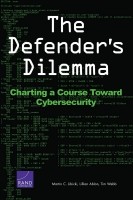| 来源类型 | Research Reports
|
| 规范类型 | 报告
|
| ISBN | 9780833089113
|
| 来源ID | RR-1024-JNI
|
| The Defender's Dilemma: Charting a Course Toward Cybersecurity |
| Martin C. Libicki; Lillian Ablon; Timothy Webb
|
| 发表日期 | 2015
|
| 出版年 | 2015
|
| 页码 | 162
|
| 语种 | 英语
|
| 结论 |
Common Knowledge Confirmed - Security postures are highly specific to company type, size, etc.; and there often aren't good solutions for smaller businesses.
- Quarantining certain parts of an organization offline can be a useful option.
- Responding to the desire of employees to bring their own devices and connect them to the network creates growing dilemmas.
- Chief information security officers (CISOs) feel that attackers have the upper hand, and will continue to have it.
Reasonable Suppositions Validated - Customers look to extant tools for solutions even though they do not necessarily know what they need and are certain no magic wand exists.
- CISOs want information on the motives and methods of specific attackers, but there is no consensus on how such information could be used.
- Current cyberinsurance offerings are often seen as more hassle than benefit, only useful in specific scenarios, and providing little return.
Surprising Findings - A cyberattack's effect on reputation (rather than more direct costs) is the biggest cause of concern for CISOs. The actual intellectual property or data that might be affected matters less than the fact that any intellectual property or data is at risk.
- In general, loss estimation processes are not particularly comprehensive.
- The ability to understand and articulate an organization's risk arising from network penetrations in a standard and consistent matter does not exist and will not exist for a long time.
|
| 摘要 |
- Know what needs protecting, and how badly protection is needed. It was striking how frequently reputation was cited by CISOs as a prime cause for cybersecurity spending, as opposed to protecting actual intellectual property. Knowing what machines are on the network, what applications they are running, what privileges have been established, and with what state of security is also crucial. The advent of smart phones, tablets, and so forth compounds the problem.
- Know where to devote effort to protect the organization. A core choice for companies is how much defense to commit to the perimeter and how much to internal workings.
- Consider the potential for adversaries to employ countermeasures. As defenses are installed, organizations must realize they are dealing with a thinking adversary and that measures installed to thwart hackers tend to induce countermeasures as hackers probe for ways around or through new defenses.
- Government efforts aren't high on CISO's lists, but governments should be prepared to play a role. By and large, CISOs we interviewed did not express much interest in government efforts to improve cybersecurity, other than a willingness to cooperate after an attack. Yet it seems likely that government should be able to play a useful role. One option is to build a body of knowledge on how systems fail (a necessary prerequisite to preventing failure), and then share that information. A community that is prepared to share what went wrong and what could be done better next time could produce higher levels of cybersecurity.
|
| 主题 | Computer Viruses
; Cybercrime
; Cybersecurity
; The Internet
; Law Enforcement
; Markets
|
| URL | https://www.rand.org/pubs/research_reports/RR1024.html
|
| 来源智库 | RAND Corporation (United States)
|
| 资源类型 | 智库出版物
|
| 条目标识符 | http://119.78.100.153/handle/2XGU8XDN/108020
|
推荐引用方式
GB/T 7714 |
Martin C. Libicki,Lillian Ablon,Timothy Webb. The Defender's Dilemma: Charting a Course Toward Cybersecurity. 2015.
|
|
文件名:
|
x1495316252819.jpg
|
|
格式:
|
JPEG
|

|
文件名:
|
RAND_RR1024.pdf
|
|
格式:
|
Adobe PDF
|
除非特别说明,本系统中所有内容都受版权保护,并保留所有权利。